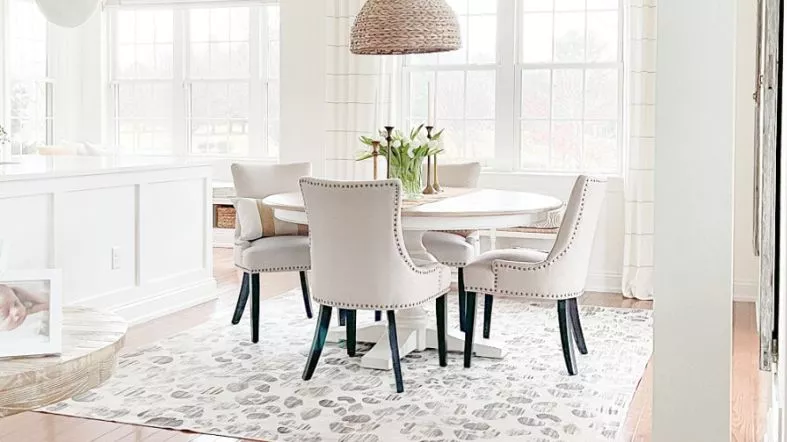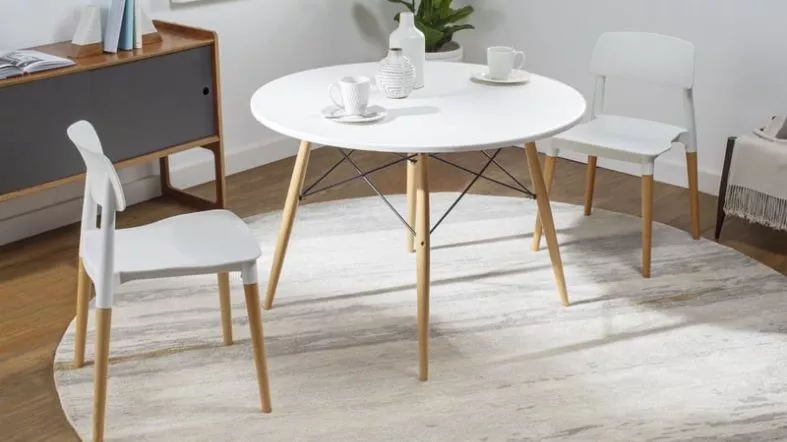Puzzled about choosing the right size rug for your 60-inch round table? You’re not alone. The right rug can make or break a room’s aesthetic.
In this guide, we’ll walk you through rug types, materials, and crucial factors to consider. Say goodbye to size confusion and hello to a stylish, well-balanced space.

What Size Rug for a 60-Inch Round Table?
For a 60-inch round table, an 8-foot diameter circular rug is generally recommended. This allows for chairs to be comfortably pulled out without catching on the rug’s edge, providing an aesthetic and practical solution.
Rug size chart for a 60-inch round table:
| Rug Size | Floor Space Covered | Space Left Around Table |
|---|---|---|
| 6 feet | 28 sq. ft. | 12 inches |
| 8 feet | 50 sq. ft. | 24 inches |
| 10 feet | 79 sq. ft. | 36 inches |
| 12 feet | 113 sq. ft. | 48 inches |
Types of Rugs Suitable for a 60-Inch Round Table
Here are some of the most common types of rugs that work well with a round table:
Area Rugs
Area rugs are large rugs that cover a significant portion of the floor. They come in various shapes, such as rectangle, square, oval, or round.
Area rugs are ideal for creating a cozy and inviting atmosphere in your room. They can also define different zones or functions in an open space.
For a round table, you can choose either a round or a square area rug. A round area rug will echo the shape of your table and create a harmonious look.
A square area rug will contrast with your table and create a dynamic look.
Circular Rugs
Circular rugs are small rugs that have a circular shape. They are usually used as accent pieces or focal points in a room.
They can add some color, texture, or pattern to your floor without overwhelming it.
For a round table, you can use a circular rug to highlight your table and create a sense of unity in your room.
A circular rug will fit perfectly under your table and create a neat and tidy look.
Square Rugs
Square rugs are small rugs that have a square shape. They are usually used as accent pieces or focal points in a room.
They can add some color, texture, or pattern to your floor without overwhelming it.
Use a square rug to highlight a round table and create contrast in your room. A square rug will offset the roundness of your table and create a dynamic look.
Runner Rugs
Runner rugs are long and narrow rugs that are usually used in hallways or entryways.
They can add some warmth, color, or pattern to your floor without covering it completely.
For a round table, you can use a runner rug to create some interest and movement in your room.
A runner rug will draw attention to your table and create a sense of direction in your room.
Factors to Consider When Choosing a Rug for a 60-Inch Round Table

When choosing a rug for your round table, you need to consider other factors besides its size and type. These factors include:
Room Size and Shape
The size and shape of your room will affect how your rug will look and feel in your space.
You need to measure your room dimensions and plan your furniture layout before buying a rug.
You also need to consider the style and theme of your room and choose a rug that complements it.
Furniture Arrangement
The furniture arrangement around your table will affect how your rug will fit and function in your space.
Decide how many chairs you want around your table, and how much space you want between them.
Aside from sofas and coffee tables, bookcases and coffee tables should be considered as well.
Color and Pattern
The color and pattern of your rug will affect the mood and atmosphere of your room. Choose a rug that complements or contrasts your existing color scheme.
A rug must also have a suitable pattern, such as geometric, floral, or abstract, for your room.
Budget Constraints
The budget constraints of your rug will affect the quality and durability of your rug.
Your rug budget should be realistic, and you should compare different options within your budget.
You also need to consider the maintenance costs of your rug, such as cleaning, repairing, or replacing it.
Maintenance Requirements
The maintenance requirements of your rug will affect the lifespan and appearance of your rug.
Your rug should be easy to clean and maintain, especially if you have pets or children.
You also need to choose a rug that is resistant to stains, fading, or wear and tear.
Underpad or Rug Pad Necessity
The underpad or rug pad necessity of your rug will affect the comfort and safety of your rug.
You need to choose a rug that has a suitable backing for your floor type, such as hardwood, tile, or carpet.
The rug should also be thick enough for your comfort level, such as plush, medium, or flat.
Seasonal Variations (Indoor vs Outdoor)
The seasonal variations of your rug will affect the suitability and versatility of your rug.
Rugs should be chosen according to the climate and weather conditions of your location.
The rug should also be suitable for indoor or outdoor use, depending on where it will be placed.
Traffic and Wear and Tear
The traffic and wear and tear of your rug will affect the durability and performance of your rug.
Rugs that can withstand high, medium, or low traffic should be chosen for your room.
The rug should also be able to handle spills, dirt, scratches, and other wear and tear in your room.
Local Retailers and Online Options
The local retailers and online options of your rug will affect the availability and convenience of your rug.
You need to choose a rug that is easy to find and buy from a reputable source, either online or offline.
In case you are unsatisfied with your rug, make sure it has a good return policy and warranty.
How to Properly Measure for a Rug Under a 60-Inch Round Table?

To properly measure for a rug under a 60-inch round table, you’ll need some tools and some steps. Here’s what you’ll need:
Tools You’ll Need
- A tape measure
- A pencil
- A paper
- A calculator (optional)
Step-by-Step Guide
Step 1
From one edge to another, measure the diameter of your table with a tape measure.
Step 2
Add at least two feet to the table diameter to get the minimum diameter of the rug you need.
The minimum rug diameter should be at least 84 inches (60 + 24) for a 60-inch table.
Step 4
If you want more space around the table, add more inches to the table diameter accordingly.
The rug diameter should be at least 96 inches (60 + 36) if you want 36 inches of space around the table.
Write down the diameter of the rug you want on a piece of paper.
Step 5
In the case of rectangular or square area rugs, you need to convert the diameter into length and width.
Simply divide the diameter by 1.414 (the square root of 2) to get both the length and width measurements.
For example, if you want an 84-inch diameter rug, then you need a 59.4-inch by 59.4-inch area rug (84 / 1.414 = 59.4).
Step 6
Write down the length and width measurements of the rug you want on a paper.
Use the tape measure to mark the dimensions of the rug you want on the floor with the pencil.
Make sure the rug is centered under the table and aligned with the walls or other furniture in the room.
Check if the rug fits well in your space and adjust the measurements if needed.
Common Mistakes to Avoid When Selecting a Rug Size
Here are some common mistakes to avoid when selecting a rug size, and how to fix them:
Choosing Too Small a Rug
A too small rug will make your table look out of proportion and your room look cramped.
It will also leave your chairs hanging off the edge of the rug, which can be uncomfortable and unsafe.
Choose a rug that can accommodate all chairs around the table, even when they are pushed back.
Choose a rug that leaves enough space between the edge of the rug and the wall or other furniture.
Overlooking Rug Thickness
A thick rug will add some height to your floor, which can affect how your table and chairs fit on it. A thick rug can also make your room look smaller and darker.
Consider the rug’s thickness when measuring, and adjust the dimensions accordingly.
Table height and chair height must also be considered, as well as rug thickness.
Ignoring Color and Texture
Your rug can clash or mismatch with your table or room if it is a different color or texture.
Having a rug that matches your table or room can create a bland or boring look.
If you want a particular effect, your rug should contrast or complement your table. You also need to choose a rug that has a pattern that suits your style and theme.
FAQs on What Size Rug for 60 Round Table
Can I use a rectangular rug under a 60-inch round table?
No, it’s not recommended to use a rectangular rug under a round table, as it may look mismatched and disrupt the aesthetic balance.
Is it essential to use a rug pad under the rug for a 60-inch round table?
Yes, using a rug pad is important to prevent the rug from slipping and to provide extra cushioning, if you have hardwood or tile floors.
Are circular rugs the only suitable option for a 60-inch round table?
No, while circular rugs are a great fit, you can also use square or oval rugs to add contrast and visual interest to the room.
Do I need to consider the rug’s thickness when measuring for a 60-inch round table?
Yes, the rug’s thickness should be considered, as it can impact the overall height and aesthetics of the dining area.
Does the rug size affect the number of chairs I can place around a 60-inch round table?
Yes, the size of the rug will determine how many chairs can comfortably fit around the table, so choose the rug accordingly.
Can I use an outdoor rug indoors for a 60-inch round table?
Yes, you can use an outdoor rug indoors, but make sure it complements your interior decor and is suitable for indoor use.
Can I place the rug under a 60-inch round table without aligning it with the walls or furniture?
Yes, aligning the rug with the walls or other furniture in the room is important to create a harmonious and balanced look in your dining area.
Conclusion
Choosing the right rug size for your 60-inch round table transforms your dining experience.
Opt for a rug that’s spacious enough to let chairs move freely and enhance your room’s decor.
This ensures comfort and style in one savvy design move. Happy decorating!
